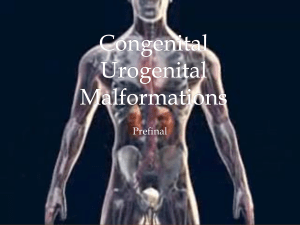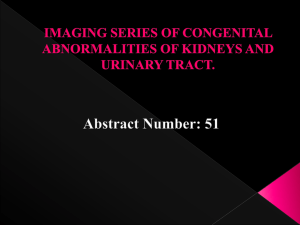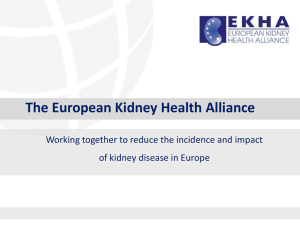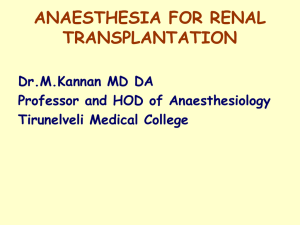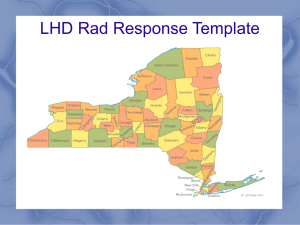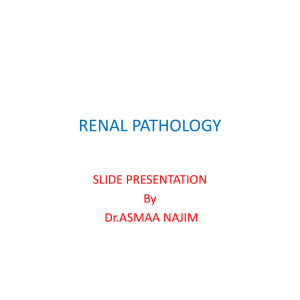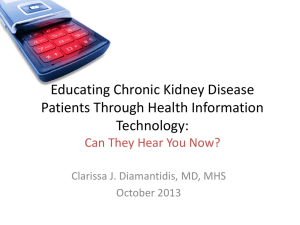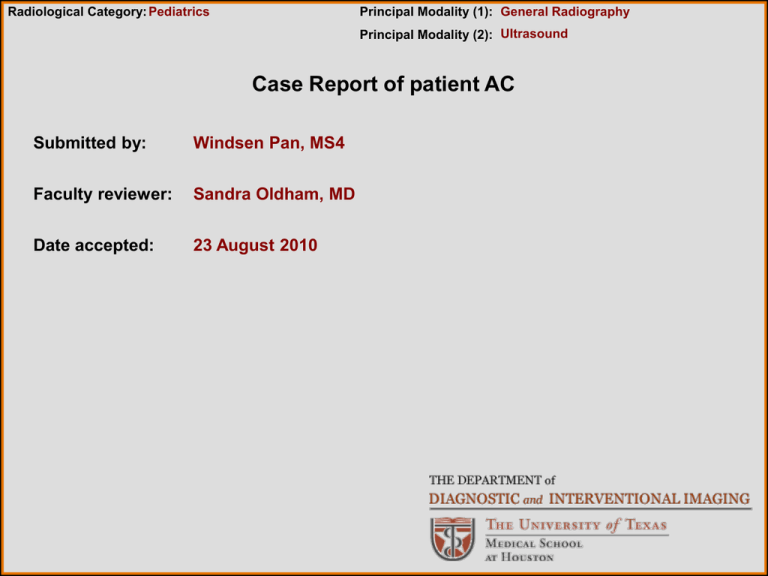
Radiological Category: Pediatrics
Principal Modality (1): General Radiography
Principal Modality (2): Ultrasound
Case Report of patient AC
Submitted by:
Windsen Pan, MS4
Faculty reviewer:
Sandra Oldham, MD
Date accepted:
23 August 2010
Case History
MC is 2 day old female born prematurely at 35 6/7 weeks at an OSH where she
presented with multiple congenital abnormalities, feeding intolerance and elevated
creatinine.
The mother had received prenatal care. Prenatal ultrasound revealed
oligohydramnios. Pt was delivered via SVD, APGARs were 8 and 9. Imperforate
anus, sacral dimple and syndactyly were noted on initial exam.
Radiological Presentations
Radiological Presentations
Radiological Presentations
Radiological Presentations
Radiological Presentations
Radiological Presentations
Radiological Presentations
Test Your Diagnosis
Which one of the following is your choice for the appropriate diagnosis?
• Autosomal Recessive Polycystic Kidney Disease
• Amniotic Band Syndrome
• VACTERL Association
• CHARGE Syndrome
• Potter’s Syndrome
Findings
Findings:
Chest/Abdominal Pediogram
A Replogle catheter lies in the proximal esophagus, most likely in the proximal pouch of an
atretic esophagus. Multiple loops of gas distended, dilated bowel are seen throughout the
abdomen. An umbillical vein catheter remains in the region of the ductus stenosis.
Skeletal Survey
A butterfly vertebrae is noted at the lumbosacral junction. The sacrum is dysplastic. Four
metacarpals are noted bilaterally. The first (radial-most) digit of the each hand is dysplastic
and demonstrates fusion of 3 digits on the left. The radial-most digit of the right hand may be
a fusion of 2 digits.
Spine Ultrasound
The tip of the conus medullaris is abnormally low in position, at L5 level. The filum terminale
appears thickened and tends towards the sacral thecal sac. The sacrum appears dysplastic.
A hypoechoic bulge is noted in the subcutaneous tissues over the sacrum, which is
suggestive of a communication to the thecal sat at S4-S5 level.
Abdominal Ultrasound
Normal renal parenchyma is not visualized in either renal bed. The right kidney demonstrates
large cystic areas that do not appear to communicate. The left kidney also demonstrates
large cystic areas that do not appear to be arranged in a collecting system pattern.
Differentials
Differentials:
• Autosomal Recessive Polycystic Kidney Disease
• Amniotic Band Syndrome
• VACTERL Association
• CHARGE Syndrome
• Potter’s Syndrome
Diagnosis:
VACTERL Association
Discussion
VACTERL Association
Non-random constellation of congenital defects, including at least 3 of the following
anomalies:
Vertebral – hemivertebrae, butterfly vertebrae, fused/extra segments,
Atresias – anal, duodenal atresias
Cardiac – atrial septal/ventricular septal defects, Tetralogy of Fallot, aortic coarctation
Tracho-Esophogeal – esophageal atresia, tracho-esophageal fistulas
Renal – horseshoe kidney, dysplastic kidney, uretopelvic obstruction
Limb – absent/deformed radii, poly/oligodactyly
Discussion
VACTERL Association
First described in 1973. Identified as VATER association.
In a 2010 international study looking at 10 million infants, 1 in 35,000 had VATER
association (did not include cardiac anomalies)1. VACTERL association has been
reported with an estimated prevalence of 1 in 6,250 newborns2.
Association of anomalies suggest derangement of mesoderm development
No single genetic etiology identified. HOXD13, FOXF1, and SHH are possible involved
genes1.
Non-mendelian inheritance pattern
Most likely a multi-factorial etiology. There have been reported associations with Trisomy
18 and babies of diabetic mothers2.
Discussion
Esophageal Atresia/Tracheo-Esophageal Fistula
1 in 3,000 live births3. Seen in about 52% of
VACTERL cases1.
Most common type is EA + distal TEF (A)
Patients present with excessive drooling and
inability to feed due to EA. TEF leads to
excessive intake of air into the GI tract, resulting
in dilation of stomach and small intestine as well
as respiratory distress from restriction of the
diaphragm. Aspiration is common.
Radiographic evidence
Prenatal US often reveals polyhydramnios.
Neonatal chest radiographs shows coiled NG tube in
proximal pouch of esophagus. Stomach and small
intestine may be distended with air, depending on
type/presence of TEF.
Contrast studies are generally not indicated due to
aspiration risk.
Discussion
Multicystic Dysplastic Kidney
Seen in about 50% of VACTERL patients1.
Occurs in 1 in 2,400 live births. Most
common renal cystic disease in the US4.
Renal cortex replaced by numerous cysts of
varying sizes. No functional renal tissue
identified. Only 20% have an identifiable
reniform shape.
Bilateral disease is incompatible with life –
25% of cases.
Ultrasound is imaging study of choice.
Helpful to differentiate between
hydronephrosis and polycystic kidney
disease.
Discussion
Tethered Spinal Cord
Subcategory of spinal dysraphisms (meningocele, myelomeningocele, spina bifida
occulta).
Developmental anomaly where the distal spinal cord is bound low in the bony spinal canal.
This is often caused by a thickened filum terminale, fibrous banding, lipoma of the filum
terminale or dermal sinus. As the bony canal grows more rapidly than the neural tissue,
tension is exerted on the spinal cord, tethering it down. The conus medullaris is typically
found below the level of L2-L3.
Associated with cutaneous markers such as nevi, dimples, hair tufts or hemangiomas.
Neurological deficits (bowel/bladder dysfunction, leg/back pain, motor/sensory
disturbances) result depending on location of tethering and tend to worsen as the canal
grows.
Not classically described as part of VACTERL but a recent retrospective study of
VACTERL patients over 14 years showed 39% of VACTERL patients with tethered cords5.
References
1. Solomon BD, et al. Analysis of component findings in 79 patients diagnosed with VACTERL
association. Am J Med Genet A. 2010 Aug 3.
2. Cinncinnati Children’s Heart Institute. VACTERL or VATER association.
http://www.cincinnatichildrens.org/health/heart-encyclopedia/disease/syndrome/vacterl.htm.
2009 Sept.
3. Kronemer KA, et al. Esophageal Atresia/Tracheoesophageal Fistula. eMedicine. 2009 Jun
23.
4. Wiener JS, et al. Multicystic Dysplastic Kidney. eMedicine. 2008 Feb 19.
5. O'Neill BR, Yu AK, Tyler-Kabara EC, Prevalence of tethered spinal cord in infants with
VACTERL. J Neurosurg Pediatr. 2010 Aug;6(2):177-82.

